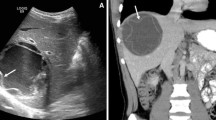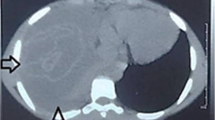Abstract
Rupture of a hydatid cyst into the biliary tract, also known as cystobiliary communication, is the most common complication of hepatic hydatid cyst. This may lead to obstructive jaundice, pancreatitis, cholangitis, and sepsis with high mortality. Imaging plays an important role in the preoperative diagnosis of this condition which facilitates its management. We studied six patients with rupture of hepatic hydatid cyst into a large bile duct in whom multidetector-row CT (MDCT) suggested the diagnosis. The imaging findings included a single hepatic cyst less than 10 cm in diameter in all the cases; interruption of the cyst wall adjacent to a bile duct signifying cyst-bile duct communication was seen in five patients. The common bile duct was dilated in all the patients, with linear membranes in four and diffuse irregular high dense intrabiliary material observed within the common bile duct in two of them. Intrahepatic ducts were dilated in all the six cases and two patients showed linear dense contents within distended gallbladder. Subcapsular and intrathoracic rupture was associated in one patient each. MDCT demonstration of hydatid cyst in the liver together with a dilated common bile duct and distended gallbladder containing high density hydatid material suggest rupture of the cyst into biliary tree. MDCT enhances demonstration of the dilated common bile duct with hydatid material inside. The diagnosis is reinforced by the demonstration of the cystobiliary communication itself.






Similar content being viewed by others
References
Kornaros SE, Aboul-Nour TA (1996) Frank intrabiliary rupture of hydatid hepatic cyst: diagnosis and treatment. J Am Coll Surg 183(5):466–470
Martí-Bonmatí L, Menor F, Ballesta A (1988) Hydatid cyst of the liver: rupture into the biliary tree. AJR Am J Roentgenol 150(5):1051–1053
Lewall DB, McCorkell SJ (1986) Rupture of echinococcal cysts: diagnosis, classification, and clinical implications. AJR Am J Roentgenol 146:391–394
Zargar SA, Khuroo MS, Khan BA, et al. (1992) Intrabiliary rupture of hepatic hydatid cyst: sonographic and cholangiographic appearances. Gastrointest Radiol 17:41–45
Tsitouridis J, Kouklakis G, Tsitouridis K, et al. (2001) Intrabiliary obstruction due to ruptured hepatic hydatid cyst: evaluation with computed tomography and magnetic resonance imaging. Dig Endosc 13:7–12
Subramanyam BR, Balthazar EJ, Naidich DP (1983) Ruptured hydatid cyst with biliary obstruction: diagnosis by sonography and computed tomography. Gastrointest Radiol 8:341–343
Shemesh E, Friedman E (1987) Radiologic and endoscopic appearance of intrabiliary rupture of hydatid liver disease. Digestion 36(2):96–100
Marti-Bonmati L, Menor F (1990) Complications of hepatic hydatid cyst: ultrasonography, computerised tomography and magnetic resonance diagnosis. Gastrointest Radiol 15:119–125
Valle-Sanz Yd, Lorente Ramos RM (2004) Sonographic and computed tomographic demonstration of hydatid cysts communicating with biliary tree. J Clin Ultrasound 32(3):144–148
Kapoor A, Vashisht S, Sharma R (1998) Intrabiliary rupture of hepatic hydatid cyst—imaging features. Tropical Gastroenterol 19(3):115–117
Montero M, Garcia A, Lopez LJ, et al. (1996) Fat fluid level in hepatic hydatid cyst: a new sign of rupture into biliary tree? AJR Am J Roentgenol 167(1):91–94
Antonopoulos P, Tavernaraki K, Charalampopoulos G, et al. (2008) Hydatid hepatic cysts rupture into the biliary tract, the peritoneal cavity, the thoracic cavity and the hepatic subcapsular space: specific computed tomography findings. Abdom Imaging 33(3):294–300
Prousalidis J, Kosmidis C, Kapoutzis K, et al. (2009) Intrabiliary rupture of hydatid cysts of the liver. Am J Surg 197(2):193–198
Atli M, Kamma NA, Voksch YN, et al. (2001) Intrabiliary rupture of hepatic hydatid cyst: associated clinical factors and proper management. Arch Surg 136(11):1249–1255
Galati G, Sterpetti AV, Caputo M, et al. (2006) Endoscopic retrograde cholangiography for intrabiliary rupture of hydatid cyst. Am J Surg 191(2):206–210
Author information
Authors and Affiliations
Corresponding author
Rights and permissions
About this article
Cite this article
Wani, N.A., Kosar, T., Gojwari, T. et al. Intrabiliary rupture of hepatic hydatid cyst: multidetector-row CT demonstration. Abdom Imaging 36, 433–437 (2011). https://doi.org/10.1007/s00261-010-9675-8
Published:
Issue Date:
DOI: https://doi.org/10.1007/s00261-010-9675-8




